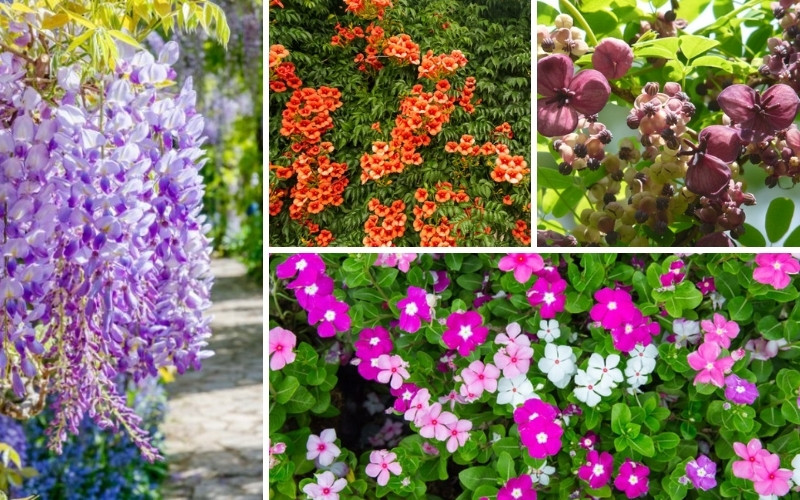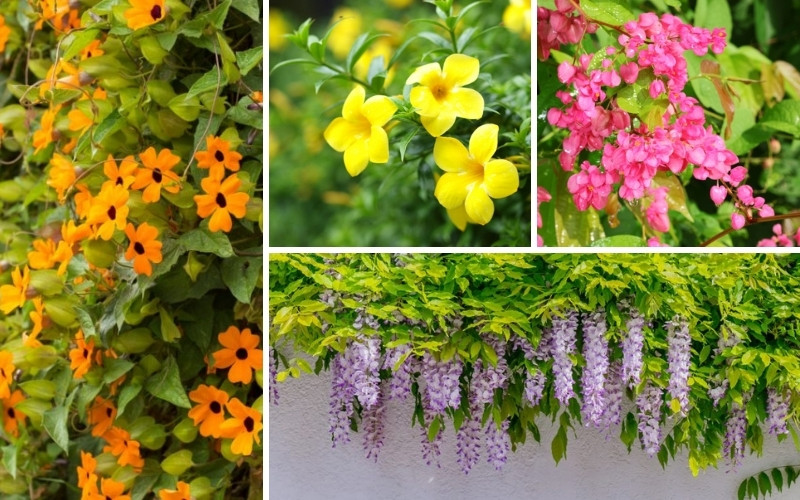
Red flowering vines lend a beautiful focal point to any garden and provide a solid, eye-catching statement that’s tough to beat.
Let’s take a closer look at ten bold, red flowering vines that are sure to wake up your flower garden this spring.
Lipstick Plant

This evergreen plant gets its name for its striking tube-shaped flowers that bear an uncanny resemblance to a tube of lipstick. This plant is native to the tropical regions of Malaysia and prefers a sunny location with indirect sunlight, away from drafts, when planted indoors. When planted in a small flower pot, this plant will provide abundant blooms year-round; just be sure to give the vines enough room to spread out.
Root rot is relatively common with lipstick plants, so be sure to plant in well-draining soil, watering only when the soil feels dry to the touch. Be sure to prune regularly after all buds have bloomed.
Coral Honeysuckle

The Coral Honeysuckle (sometimes called the Trumpet) is a high climbing vine, sometimes reaching 18 to 20 feet. Its trumpet-shaped flowers are bright red on the outside with yellow centers with evergreen leaves when planted in a warm climate.
This showy beauty begins blooming in the spring and does best with full sun to part shade. The bright flowers attract butterflies and hummingbirds and have medicinal qualities. Ground coral honeysuckle leaves can take the sting out of bee stings and relieve coughs and sore throat.
Rangoon Creeper

The Rangoon Creeper is a woody vine with flowers in bright clusters. These sweet-smelling flowers bloom each spring in four to five-inch groups that continuously “creep” toward the sunlight and are striking as ornamental flowers for archways and gazebos. Blooms are continuous in a warm, tropical environment.
This vine is adaptable to well-drained soils and performs best in full sun with partial shade during the day’s heat. The Rangoon Creeper is an aggressive grower that needs plenty of room to spread out with vines that reach 12 to 15 feet.
Red Mandevilla Vine
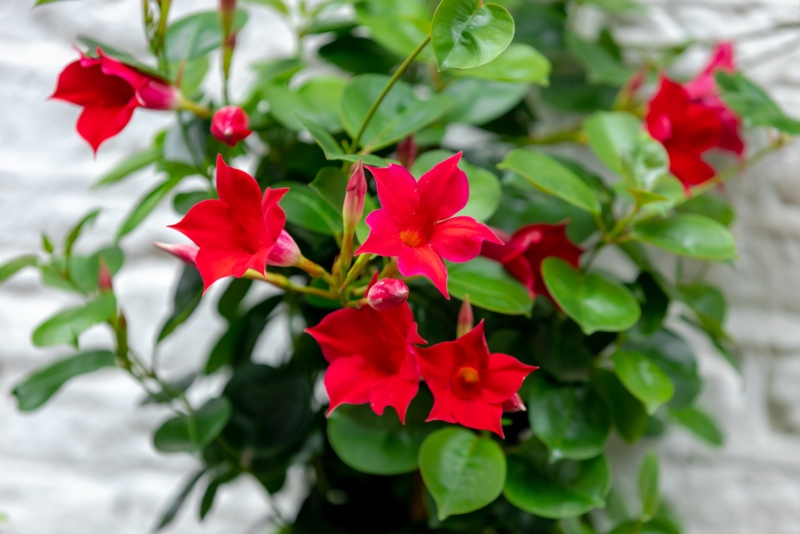
For an arresting pop of color, one needs to look no further than the Red Mandevilla plant. Sporting bold, red blossoms that stay in bloom longer than most other plants, this vine has glossy, evergreen foliage and is a perennial in the warmer planting zones nine to eleven.
This fast-growing vine blooms during the heat of summer and favors full to part sun. The Red Mandevilla grows well in containers and hanging baskets with beautiful blossoms that attract butterflies and wildlife.
Red Climbing Fuchsia Vine

The Red Climbing Fuschia vine is a hardy plant that can withstand temperatures down to 50 degrees. This vine blooms from June to November in most climates and requires pruning each spring to encourage new growth. This vine is not well-suited to hanging baskets as it tends to become “leggy,” with sparse blooms, but it does exceptionally well when trained along a fence or trellis.
The masses of red, dropping flowers put on an irresistible display for hummingbirds all season long that will last until frost.
Red Morning Glory Vine
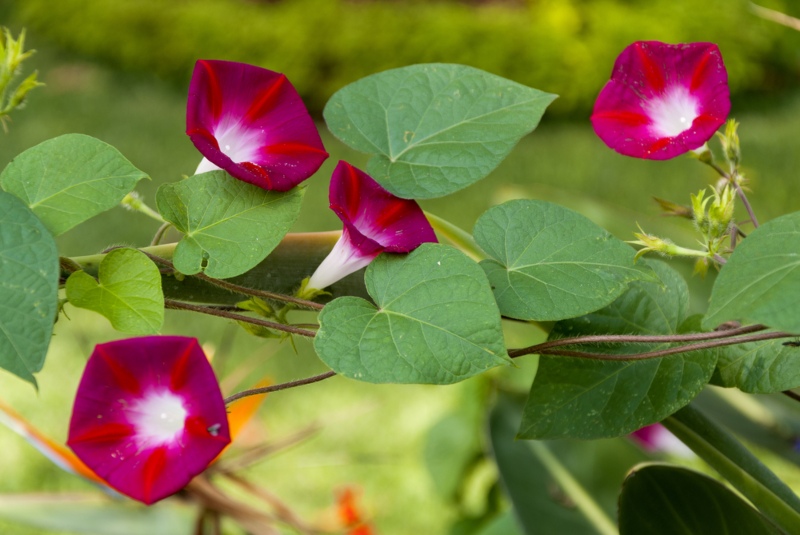
Red morning glory, also known as Mexican morning glory or red star plants, is a fast-growing, sun-loving annual. While wildlife adores this pretty vine, some jurisdictions consider it a weed or a non-native invasive species, and its cultivation is illegal in some areas.
Morning glory does well in full sun producing clusters of long red flowers. While beautiful when viewed as a wildflower, morning glory can be a bit aggressive when planted in the flower garden. The vine can reach lengths of 50 feet and pugnaciously climbs fences and trees.
Red Trumpet Creeper Vine

The trumpet creeper vine is a plant that produces bulky, bright, tubular flowers and can easily overwhelm support structures in the garden. This plant is hardy nearly to the point of hostility and knows how to take a hit, primarily due to the plant’s recruitment of bodyguards for protection. The U.S. Department of Agriculture has classified it as a weed.
Trumpet creepers produce a sweet nectar that many insects find irresistible. So irresistible that these insects will aggressively attack and destroy perceived threats to the plant to maintain the nectar supply. These fascinating plants display beautiful blooms that attract bumblebees and hummingbirds as their primary pollinators.
Red Climbing Roses (New Dawn)
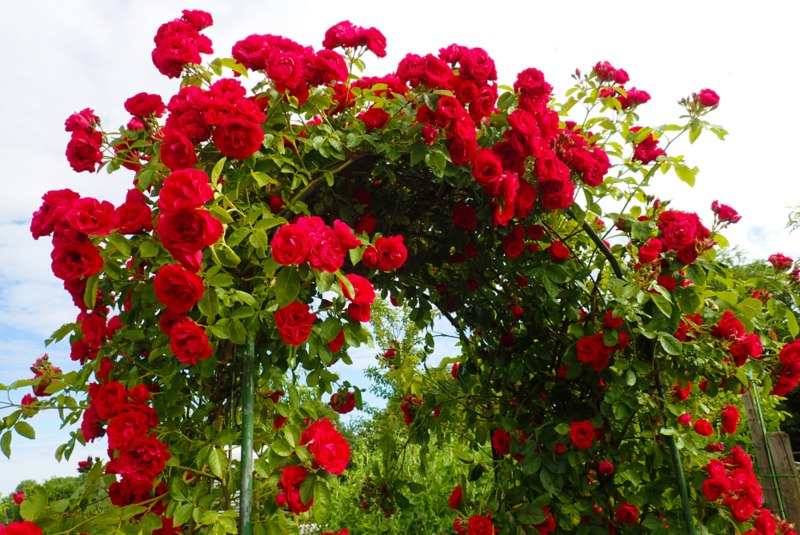
There are at least 15 different red climbing roses, and the New Dawn is one of the most popular varieties. This sweet-smelling, fragrant climber can reach heights of 20 feet. While the smell is intoxicating, many growers are attracted to the plants’ disease-resistant qualities that allow easier cultivation and growth.
This rigorous climber produces a compact, deep red blossom and performs best when planted in full sun. Though undeniably attractive, these vines take a bit more time than other entries to mature, with an average time of three to five years.
Dwarf Red Jade Vine

Vibrantly announcing itself is the fast-growing dwarf red jade vine. Producing long chains of drooping flowers, these plants bloom from late fall to spring in warmer climates. This alluring Brazilian native is surprisingly tolerant to the cold and can even endure a bit of frost, remaining cold hardy down to 25 degrees.
These plants require moist, thick soil and conduct themselves beautifully with a layer of mulch around the base, as they prefer their roots covered. Plenty of direct sunlight, warmer temperatures, and patience are recipes for success with dwarf red jade, as they can take two to three years before blooming.
Scarlet Runner Bean

Hundreds of years ago, this plant was grown in the mountains of Central America and Mexico as a food source, but today, the Scarlett runner bean is more commonly an ornamental flower. This vine produces showy displays of short-lived, red flower clusters.
With an appearance similar to that of pole beans and known to grow more than 15 feet in length, Scarlett runner beans have a thick, starchy root used as a food source in Mesoamerica.
Deciding on a flowering vine to serve as a focal point in your garden is a fascinating journey that can lead to some unexpected final results.





